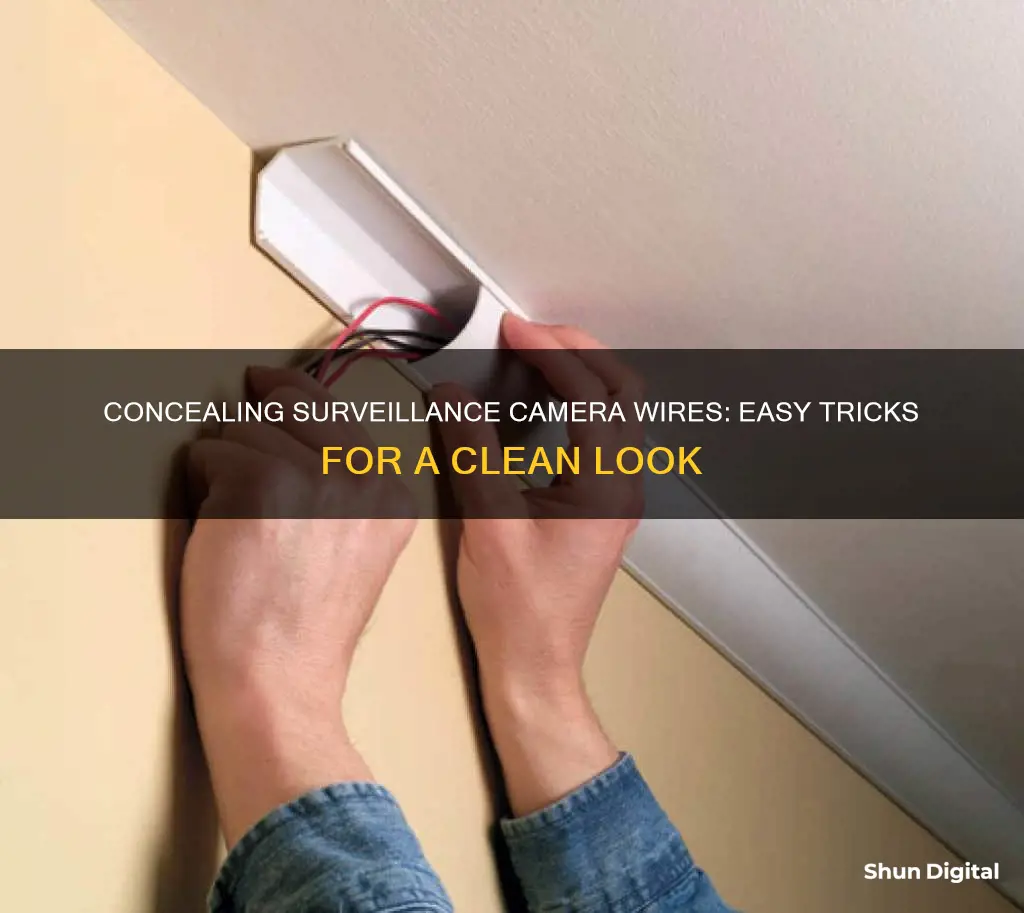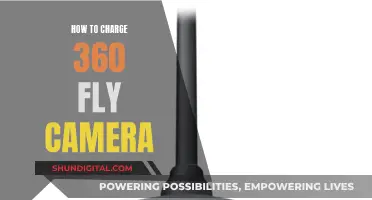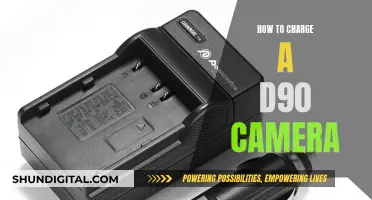
Surveillance cameras are a great way to monitor your property and deter intruders. However, exposed wires can ruin the aesthetic of your home and provide an easy opportunity for intruders to disable your security system by cutting the cables. Luckily, there are several simple and inexpensive ways to hide these wires, including painting the wires to match the walls, using cord covers, hiding wires within baseboards, or using plastic tubing. For those who want to avoid the hassle of concealing wires altogether, wireless security cameras powered by batteries or solar panels are also an option.
| Characteristics | Values |
|---|---|
| Paint the wires | Paint the wires the same colour as the walls and staple them in place |
| Cord cover | Find a cord cover that matches the walls |
| Baseboards | Remove the baseboards and feed the wires through the gap between the wall and the floor |
| Furniture | Hide wires behind large pieces of furniture such as bookshelves or under the carpet |
| Plastic tube | Feed wires through a plastic tube to protect them from harsh weather conditions and external damage |
| Wall/ceiling | Drill holes in the wall/ceiling and thread the wires through |
| Wireless security camera | Install a wireless security camera that is powered by batteries or solar panels |
What You'll Learn

Paint the wires to match the walls
Painting the wires the same colour as your walls is a great way to disguise your surveillance camera wires. This method is most effective for outdoor wires, which can be stapled to the walls and painted over.
Firstly, you will need to source a paint colour that matches your walls. If you know the name or brand of the paint used on your walls, you can simply purchase the same paint. If not, you can try one of the following methods to find a matching colour:
- Take a physical chip from your wall to a paint store. They will be able to analyse the chip and provide you with a precise colour match.
- Use an at-home colour-matching tool or a phone app. These tools use small sensors to analyse the colour of your wall and provide a precise reading.
- Bring home paint samples and test them against your wall. This method works best if you know the brand of the paint used on your wall, but you can also test different brands to find a close match.
Once you have found a matching paint colour, you can begin painting your surveillance camera wires. Before you start, staple the wires to the walls using a staple gun. This will ensure that the wires are secure and that you are only painting the parts of the wire that are visible.
When painting, be sure to use a small paintbrush and work carefully to avoid getting paint on any surrounding surfaces. It is also a good idea to allow the paint to dry fully and then inspect the wires to see if they require a second coat.
By painting your surveillance camera wires to match your walls, you can effectively disguise them and ensure that your security system is less noticeable to intruders.
Mastering Dark Mode Photography: A Guide
You may want to see also

Use a cord cover
Using a cord cover is an excellent way to hide surveillance camera wires. Cord covers, also known as raceways, are plastic coverings that can be attached to walls, baseboards, or ceilings to conceal wires. They are easy to install and provide a neat and inconspicuous finish. Here are some detailed instructions on how to use a cord cover to hide your surveillance camera wires:
Choose the Right Cord Cover:
First, select a cord cover that matches the colour of your wall, ceiling, or surface where you will be installing it. Cord covers come in various colours, sizes, and designs, so choose one that blends seamlessly with your decor.
Plan the Installation:
Before purchasing the cord cover, carefully plan the installation. Measure the length of the camera wire you need to cover and select a cord cover that is long enough to shield the wire from the outlet to the device. You may need to buy multiple pieces and cut them to the appropriate length.
Install the Cord Cover:
Most cord covers have an adhesive backing for easy installation. Simply remove the adhesive cover and attach the cord cover to the desired surface. If your cord cover doesn't have an adhesive, you can use hooks, glue, or other tools to secure it in place.
Position the Wires:
Once the cord cover is installed, position the surveillance camera wires inside the channel of the cord cover. If the cover has a removable lid, place the wires inside and secure the lid. If the cover doesn't have a removable lid, you may need to slip the wires into the channel through a hole.
Secure the Wires:
Ensure that the wires are securely in place and won't shift or move around. You can use cable clips, zip ties, or adhesive to secure the wires within the cord cover.
Additional Tips:
- If you are installing the cord cover outdoors, choose a durable and weather-resistant option.
- You can paint the cord cover to better match your wall colour or decor.
- If you need to hide wires along multiple walls or surfaces, you may need to use multiple cord covers and join them together.
- Cord covers are an excellent option for hiding wires along walls, baseboards, or ceilings, but if you want to hide wires inside walls, you may need to consider other methods such as in-wall conduits or wireless cameras.
Using a cord cover is a straightforward and effective way to hide surveillance camera wires, providing a neat and inconspicuous finish while also protecting your wires from potential damage or tampering.
DNG and ARW: Adobe's Camera Raw Compatibility Mystery
You may want to see also

Hide wires within baseboards
Hiding surveillance camera wires within baseboards is a neat and effective method to consider. Baseboards, also known as narrow wooden boards, run along the lowest part of the wall, providing a clever hiding spot for wires. This method is particularly convenient if you have multiple doorways in your home.
- Remove the baseboards: Carefully take off the baseboards to access the gap between the wall and the floor.
- Feed the cables: Place the wires in the gap, ensuring they are in the correct position and aligned with the desired path of the wires.
- Reattach the baseboards: Once the wires are in place, securely put the baseboards back, making sure they are properly sealed.
By concealing the wires within the baseboards, you not only achieve a tidy and unobtrusive installation, but you also protect the wires from potential damage or tampering. This method can be easily executed without the need for a licensed contractor, making it a cost-effective solution.
Additionally, you can enhance the concealment by painting the baseboards to match the colour of the wires, ensuring they blend seamlessly with their surroundings. This extra step adds an extra layer of discretion to your surveillance setup.
Remember to plan the wiring route in advance and consider combining this technique with other wire-hiding methods, such as using furniture or decorative pieces to further obscure the wires from view.
Checking Your Alro Camera's Battery Status: A Step-by-Step Guide
You may want to see also

Use a plastic tube
Using a plastic tube is an effective way to hide security camera wires and protect them from harsh weather conditions and external damage. This method is inexpensive and simple, but it may be a little complex if you are not tech-savvy.
First, you will need to determine the location of the wall stud and start drilling a hole large enough to accommodate the flexible tube. Do the same next to the security camera. Insert the tube through the first hole and retrieve it at the other end. Then, thread the wire through the tube and pull the loose end out of the opposite hole.
If you are not confident about performing this task, you can contact a professional to help you. This method will make the wires almost inaccessible unless you seek professional help, so keep that in mind.
Another option is to use electrical tape. First, clean the area around the wires with alcohol, then wrap the tape around the wires, ensuring that you cover the entire length of the security system wires.
Manual Focus Cameras: How to Master Precise Control
You may want to see also

Install a wireless security camera
If you're looking to install a wireless security camera, there are a few steps you should follow to ensure a smooth process. Firstly, decide on the location of your camera, taking into account factors such as the field of view, height, and whether you have attic or basement access. Mark the spots for installation and measure the distances to plugs or switches for wiring. Double-check these spots with a wire detector to avoid any mishaps.
Next, you'll want to drill holes for the screws and wiring. For direct connection, feed the wiring through and place the bracket, sealing it appropriately. Install the mounting bracket and connect the camera to the network before placing it on the bracket.
Now, install the camera onto the bracket and sync it with any other connected devices, such as smart sensors or video doorbells. Ensure that you test the camera to confirm it is working correctly.
Additionally, remember to consider the placement of your camera in relation to its power source. If the power outlet is far away, you may need to run an extension or use batteries.
Wireless security cameras offer a flexible and convenient way to enhance your security without the hassle of complicated wiring.
Focusing Night Landscapes: Camera Tricks for Stunning Shots
You may want to see also
Frequently asked questions
You can use a plastic tube to hide your camera wires. This method also helps protect the wires from harsh weather conditions and external damage.
You can hide your camera wires by stapling them to the corner of the wall and painting over them using the same colour as your walls.
You can hide your wires by placing them inside or behind large pieces of furniture, such as bookshelves and mantels, or under the carpet.
The easiest way to hide your camera wires is to use a cord cover that matches your walls perfectly.







